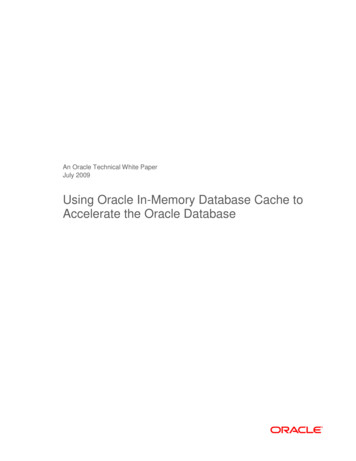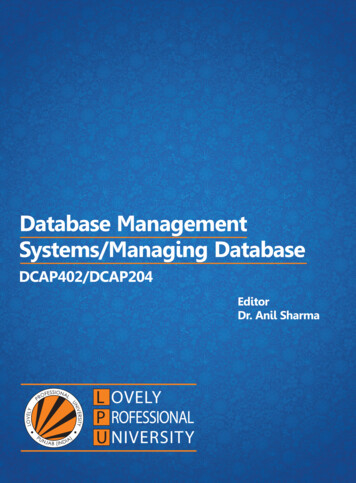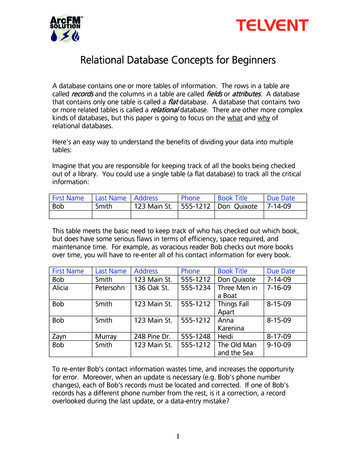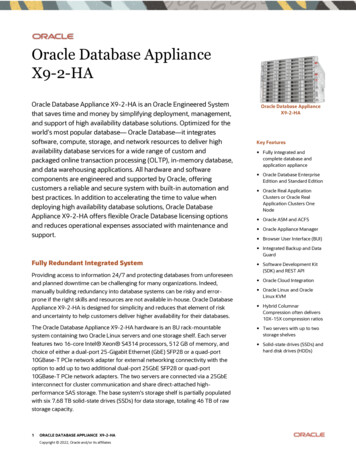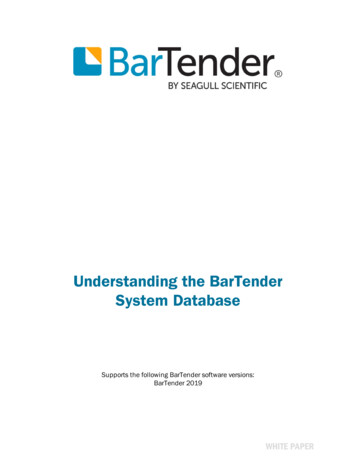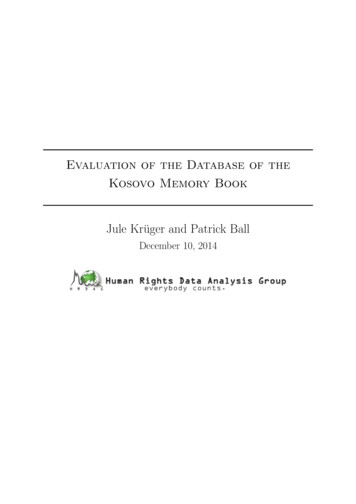
Transcription
Evaluation of the Database of theKosovo Memory BookJule Krüger and Patrick BallDecember 10, 2014
Contents1 Executive summary32 Project description: The Kosovo Memory Book53 Database structure and quality74 Descriptive analysis of database fields84.1Victim categories and types of violations . . . . . . . . . . . . . . . . . .84.2Victim code . . . . . . . . . . . . . . . . . . . . . . . . . . . . . . . . . .104.3Victim names . . . . . . . . . . . . . . . . . . . . . . . . . . . . . . . . .104.4Victim status and membership in armed formations . . . . . . . . . . . .114.5Victim sex . . . . . . . . . . . . . . . . . . . . . . . . . . . . . . . . . . .134.6Victim ethnicity . . . . . . . . . . . . . . . . . . . . . . . . . . . . . . . .134.7Victim date of birth. . . . . . . . . . . . . . . . . . . . . . . . . . . . .154.8Victim place of birth . . . . . . . . . . . . . . . . . . . . . . . . . . . . .184.9Victim place of residence . . . . . . . . . . . . . . . . . . . . . . . . . . .204.10 Date of violation . . . . . . . . . . . . . . . . . . . . . . . . . . . . . . .224.11 Place of violation . . . . . . . . . . . . . . . . . . . . . . . . . . . . . . .245 Sources of the Kosovo Memory Book database285.1Number of documents per individual record . . . . . . . . . . . . . . . .285.2Descriptive summary of source documents . . . . . . . . . . . . . . . . .336 Evaluation of database completeness140
6.1Other data sources for comparison . . . . . . . . . . . . . . . . . . . . . .406.2Cross-source comparison . . . . . . . . . . . . . . . . . . . . . . . . . . .436.2.1Reporting over time . . . . . . . . . . . . . . . . . . . . . . . . .456.2.2Reporting over space . . . . . . . . . . . . . . . . . . . . . . . . .476.3Evaluation of record capture . . . . . . . . . . . . . . . . . . . . . . . . .506.4Potential victims . . . . . . . . . . . . . . . . . . . . . . . . . . . . . . .577 Conclusions and recommendations597.1Recommendations . . . . . . . . . . . . . . . . . . . . . . . . . . . . . . .597.2Directions for future research . . . . . . . . . . . . . . . . . . . . . . . .602
Chapter 1Executive summaryIn March, 2012, the Humanitarian Law Centre (HLC) in Belgrade, Serbia, asked theHuman Rights Data Analysis Group to evaluate their database of human losses duringarmed conflict in the territory of the Former Yugoslav Republic (FYR) between 1998 and2000. In this report, we present our findings with regard to the completeness and qualityof the Kosovo Memory Book database (KMBD). The database is a joint project betweenthe HLC in Belgrade and the Humanitarian Law Centre Kosovo (HLC-Kosovo).Our evaluation consisted of four visits to HLC-Belgrade, three by Jule Krüger (July2012, March 2014, and November 2014) and one by Patrick Ball (November 2012).1 Thevisits consisted of technical demonstrations of the database by KMB staff; discussionswith the KMB team about their research and field processes; the methodology by whichthey classified deaths by type of death; and extensive reviews of how KMB staff determinewhether multiple reports refer to the same victim or to different victims (called matching).In addition to the discussions with the KMB team in Belgrade, we conducted a descriptiveanalysis of the KMB database itself. A companion report to this one has been preparedby Professor Michael Spagat, and it comes to substantially the same conclusions as thosewe present here.From our discussions with the KMB team and our analysis of the database, we conclude that the Kosovo Memory Book documents all or nearly all the human losses duringconflicts in Kosovo during the period 1998–2000. By “nearly all,” we mean that in ouropinion, it is very unlikely that there are more than a few tens of undocumented deaths.Our analysis is based on a comparison of the KMB database to ten other databasesof victims in Kosovo during this period. We matched records from the other databases1Further information was obtained from the KMB team in Belgrade via email, video calls, and theirprovision of supplementary information.3
to the KMB to determine whether any of the deaths documented by earlier projectshad been missed by the HLC and HLC-Kosovo research teams. In a three-stage process,HRDAG and the KMB team compared all ten databases to the KMB, and we determinedthat it is very unlikely that there are any additional killings in those databases notalready documented in the KMB. This finding, combined with our finding that the KMBdocuments more deaths for every period and every region than any of the other databases,2leads us to conclude that the KMB register of war victims is very close to a completeenumeration.The Kosovo Memory Book database covers human losses in the conflict during 1998–2000, and it documents 13,517 war victims. In addition, there are 1,603 potential victimswhose war victim status has not been confirmed. Based on the documentation patterns,we believe most of these records will not be confirmed, and therefore they will be addedto the list of 2,881 deaths classified as ‘not war’ victims (see Sections 4.1, 5.1, and 6.4).The descriptive analysis in Chapter 4 shows that the great majority of war victimsare civilians, most were killed (as opposed to disappeared), most were male, most wereAlbanian, and most were killed in 1999; in these examples, “great majority” and “most”mean more than 80%. One curious finding is that demographically, the group most atrisk of being killed were older people, especially older men. This is partly because Kosovohad a relatively young population, so there are proportionally fewer older people, but itis nonetheless noteworthy; see Section 4.7 for more discussion.The report begins with a discussion of HLC’s and HLC-Kosovo’s project, including thelegal definitions that were used to define “victims” of the conflict in Chapter 2. Chapter 3briefly describes the technical aspects of the database design. Chapter 4 opens a substantive analysis of the database by providing statistical descriptions of the war victims,and Chapter 5 examines the source materials that HLC used to register and documentall victims. Chapter 6 is perhaps the most important chapter: it considers how the KMBcan be understood as a complete enumeration of all the victims of the conflict in Kosovofrom 1998–2000. Chapter 7 reviews our conclusions and recommendations.2With two puzzling exceptions: see Section 6.2.1 for a discussion of weekly counts of victims documented by the Democratic League of Kosovo (LDK) that may be due to date encoding errors in thisparticular data source. See Section 6.2.2 for a discussion of possibly inaccurate victims records reportedfor the municipality of Kaçanik/Kačanik by the OSCE.4
Chapter 2Project description: The KosovoMemory BookThe Kosovo Memory Book database (KMBD) of the HLC and HLC-Kosovo documentshuman losses in connection with the war in Kosovo between January 1, 1998, and December 31, 2000.1 The KMB’s focus on human losses is geared towards lethal humanrights violations in connection with the armed conflict.2 The objective is to document allindividuals who were killed or disappeared in connection with the war in Kosovo.The HLC and HLC-Kosovo pursue various goals in establishing a register of warvictims, beginning with a clarification about what happened in this past episode of armedconflict. The most important goal is to restore the dignity of those affected by namingthe victims and providing them a monument. Further objectives are to support processesof transitional justice and criminal prosecution, as well as to assist other initiatives of1The definition of “armed conflict” (i.e., war) is based on a decision of the International CriminalTribunal for the Former Yugoslavia (ICTY) Appeals Chamber in the Tadic case, Paragraph 70 (October1995). “Armed conflict” is defined as a period that involves the use of armed force or the occurenceof protracted armed violence between armed groups across states or within a state. Hereby, armedgroups are understood as either governmental authorities or non-governmentally organized armed groups.The temporal focus was established in orientation to the official conflict dates adopted by the ICTY.The ICTY’s mandate period ranges from February 28, 1998, to mid-June 1999. Because killings andabductions of ethnic Serbs and Roma, as well as so-called ‘collaborators’ and proponents of the KosovoLiberation Army continued after the official conflict end date, the HLC and HLC-Kosovo extended theirtemporal focus to the end of 2000 when post-conflict violence finally subsided. The territorial choicecovers murders and disappearances in connection with the war in Kosovo in the territories of Kosovo,Montenegro, and Serbia, as well as on Kosovo’s border areas with Albania and Macedonia. For detailson definitions, as well as the temporal and spatial focus, please refer to the accompanying methodologydocument by Nataša Kandić of the HLC.2With the current focus on lethal violations, the HLC and HLC-Kosovo are evaluating approximately20% of their physical archive. It is the HLC’s and HLC-Kosovo’s explicit goal to expand the evaluationof their archive to non-lethal violence in the future.5
post-conflict resolution.These goals are being achieved by publishing the KMB in four volumes of victimnarratives, by providing a digital list of victims online,3 and in advocating with regionalpartners for the establishment of a regional truth commission that is to investigate warcrimes.HLC started to collect data on human rights violations during field missions in Kosovoin 1998 and maintained a field office in Pristina until September 2010.4 In addition tofield research trips, information on human rights violations was obtained from familymembers and witness statements, local and foreign newspapers, as well as other mediasources, reports of local and international governmental and non-governmental organizations, community leaders, and many other types of material.5The idea that a Kosovo Memory Book database could be created by systematizingcomprehensive information on human losses emerged in 2006. A digital database ofhuman losses was started in 2005. The HLC and HLC-Kosovo continue with independentfield research and the collection of witness statements until today. In January 2012, theHLC and HLC-Kosovo expanded data collection to obtain other types of documents, toverify personal facts of victims, to compare the war victim register to those of otherorganizations, and to assess their completeness. The goal is to create an enumeration ofall human losses in connection with the war in Kosovo between 1998 and 2000.3The version of the Kosovo Memory Book database as of November 7, 2014, which was analyzed for the purposes of this evaluation, can be found at the following websites: http://www.kosovomemorybook.org/ (English), http://www.liberkujtimiikosoves.org/ (Albanian), and http://www.kosovskaknjigapamcenja.org/ (Serbian).4Since HLC-Kosovo became an independent partner organization, the KMB database is now beingshared between both groups.5In evaluating information, a very wide definition of what material may constitute a ‘source’ isadopted. Please see the accompanying methodology document by Nataša Kandić (HLC) for detailson the KMB team’s data collection strategy and terminology.6
Chapter 3Database structure and qualityThe database is written in PHP for an html interface on top of a MySQL (5.1) database.1The database structure is extremely complicated, with over 150 tables organized in thefollowing groups: shared codebooks, users, employment, courses, tags, documents, persons, events, trials, armed formations, financial, and analysis log.One of the most valuable aspects of the database is the separation into “source” and“judgment”layers. Among the most important parts of a database of this kind is managingmultiple streams of potentially contradictory information. The HLC’s and HLC-Kosovo’sdatabase preserves all the original source information, and offers a second layer in whichtheir judgments can be recorded. This approach means that rates of agreement anddisagreement in the original sources can be calculated, and information is never lost,even when contraditory sources are merged.The database is designed so that nearly every string field can be recorded in English,Croatian, Serbian, and Albanian. This provides tremendous detail for reports, and is anastonishing level of work that should be acknowledged.In the KMB database, one person could be linked to many events by playing differentroles in each event (as witnesses, victims, or perpetrators); similarly, each event has thepossibility to include many people. The event structure is an extremely useful groupingstructure which in theory enables the database to describe a kind of historical narrative,colligating the individual victims’ experience into events. This will enable a wide rangeof possible analytic approaches, both quantitative and historical.1The database software is being developed and maintained by Abacus in Zagreb, Croatia.7
Chapter 4Descriptive analysis of databasefieldsIn this chapter, we review the various fields in the Kosovo Memory Book database thatprovide information on individuals who were killed or disappeared in connection with thewar in Kosovo in the period of 1998–2000. The goal is to evaluate the quality of theinformation presented.4.1Victim categories and types of violationsThe database presented for evaluation contained a total of 18,001 individuals the HLCand HLC-Kosovo reviewed in preparation of the Kosovo Memory Book for the three-yearperiod 1998–2000. These individuals were classified into different categories of victimsbased on whether they can be confirmed as victims of the conflict, and what they enduredduring the war.Individuals in the database were divided into three categories: ‘war victims,’ ‘potentialvictims,’ and ‘not war victims.’ A ‘war victim’ is a person who lost her/his life or wentmissing during or in connection with the armed conflict, irrespective of whether she/hewas a civilian or a member of armed forces under the control of one of the parties to theconflict at the time of her/his death or disappearance.‘Potential victims’ are individuals whom the KMB team has yet been unable to identify as war victims. This is due to missing information on the circumstances of therelevant deaths or disappearances that would allow for confirming a connection with thewar in Kosovo. Potential victims are currently still subject to field research for purposes8
of determining whether they are war victims or not. ‘Not war victims,’ in turn, are individuals for whom it was established that a death/disappearance in connection with thewar in Kosovo did not occur.1The KMB differentiates among the following violation categories for war victims:‘killings,’ ‘disappearances,’ and ‘death caused by war.’ ‘Killings’ designate the deathsof individuals that occurred in connection with the armed conflict. A ‘disappearance’ isdefined as the deprivation of freedom, detention, abduction or any other form of captivityduring hostilities followed by denial or refusal of the responsible actors to reveal the fateor location of the missing person. Based on this definition, individuals are registered as‘disappeared’ when they or their bodies have not been found to date. A ‘death causedby war’ denotes the death of civilians due to wartime food shortages, harsh conditionswhile on the run or in hiding, helplessness in the wake of forced separation from familymembers, lack of medicine or medical assistance, stress related to deportation, etc.2For potential victims, the type of violation remains ‘unknown’ until sufficient information on the case is available that helps to determine whether the case is to be addedto the war victims or the ‘not war’ victims register.Among victims whose deaths are not attributed to the war (‘not war victims’), thefollowing categories were used to denote why an individual was not considered a victim inrelation to armed conflict in Kosovo: ‘found alive,’ ‘natural death,’ ‘death by accident,’and ‘unknown.’ For example, some officially missing persons were later on located inSerbian prisons. For other victims, family members stated that they died of naturalcauses, for instance, because of age, or as a result of ordinal criminal offense, or in atraffic accident that was unrelated to the war. ‘Unknown’ victims, in turn, are individualsfor whom HLC/HLC-Kosovo were unable to establish their identities within the localcommunities, i.e., individuals with these names don’t seem to exist. Furthermore, somemissing persons requests were canceled at relevant institutions for unknown reasons.Table 4.1 gives a summary of victims in terms of their classification into victim categories and violations. As can be seen, there is no missing information in the victimcategory and violation fields. Killings constitute the largest share of violations observed(11,532 total killings).31Exact definitions of terms used in the KMB are provided in the methodology document by NatašaKandić (HLC) that accompanies this report.2See previous footnote.3The database provided for evaluation contained an additional 377 ‘not war’ victims. These individuals were, however, excluded from Table 4.1 because the date of their death occurred outside of the1998–2000 time period.9
Table 4.1: Reported victims, by violation and victim anceFound aliveDeath caused by warDeath by accidentNatural deathTotal4.2War(%)11532 85.300.01704 12.600.02812.100.000.013517 100.0Potential(%)00.01603 100.000.000.000.000.000.01603 100.0Not war(%)00.01194 41.400.01308 45.400.02157.51645.72881 100.0Total(%)11532 64.12797 15.517049.513087.32811.62151.21640.918001 100.0Victim codeEach victim has a unique identifier number assigned in the KMB database which helpsto differentiate between victim dossiers.4.3Victim namesIndividual victims are identified by their name information which consists of a last name,a father’s name, and a first name.In general, when a piece of name information was unknown HLC staff left the relevantname field blank. However, after a closer inspection of name values, we found that insome cases the codes ‘NN’, ‘N’, or ‘N.’ – likely for Serbian ‘nepoznat,’ i.e., unknown, –may have also been used to denote missing name information. Furthermore, we noticedthat in some cases name field information only consisted of a single or two characters, orone character followed by a punctuation mark.4Because name field information of only one or two characters is not meaningful tosufficiently identify individuals, we count such field values as missing. Here especiallythe use of ‘N’ or ‘N.’ is misleading as to whether a name value is missing or a namestarted with the letter ‘N’. In Table 4.2, the resulting amount of name missingness, aftername values of fewer than three characters were accounted for, is summarized by victimcategories and name fields. Please note that the name missingness categories in Table 4.2are mutually exclusive. For example, records with first and father’s name missing are notalso counted among records with first, father’s, and last name missing.An anonymous victim in this study is defined as an individual who does not have4Serbian or Albanian names of only three-character length exist.10
Table 4.2: Name missingness, by name field and victim category.Field(s) NA/CategoryFather’s nameFirst nameFirst, father’s nameLast nameFather’s, last nameFirst, father’s, last nameFirst, last nameWar (%)169 0.93 0.00 0.00 0.00 0.00 0.00 0.0Potential (%)1095 6.133 0.218 0.122 0.115 0.15 0.02 0.0Not war (%)1440 8.040 0.231 0.214 0.112 0.11 0.01 0.0Total (%)2704 15.076 0.449 0.336 0.227 0.16 0.03 0.0information on the first and last name combined, i.e., the last two rows in the abovetable. As can be seen in Table 4.2, there are no anonymous records among war victims,as the number of cases with missing information on last and first name combined is 0.5Among potential victims, 7 are anonymous. Among ‘not war’ victims, 2 are anonymous.The fact that no anonymous victims are contained in the war victims register atteststo the quality and intended accuracy of this database. The fact that there are anonymous victims within the potential and ‘not war’ victims registers reflects the uncertaintyassociated with these records. The collection of name information of conflict victims is incontrast to data projects that provide anonymous victim counts to establish the numberof individuals affected by some violence. The name information provided by HLC allowsfor cross-validation of whether stated human losses can be traced back to real people.In the remainder of the descriptive analysis in Chapter 4, we are only concerned withthe total of 13,517 war victims that HLC/HLC-Kosovo established to be victims directlyrelated to armed conflict in Kosovo, or deaths caused by the war.4.4Victim status and membership in armed formationsIn the Kosovo Memory Book, war victims are classified according to individual status.The possible status types are ‘civilian,’ ‘soldier,’ and ‘police.’ A civilian is anyone whois not a member of an armed force or a member of an organized armed group that isparty to the conflict. Status information is summarized in Table 4.3. There is no missinginformation on war victims’ individual status at the time of death/disappearance.5Two of the 3 war victims with missing first name were babies who died before their parents gavethem a name. The third war victim is a KLA soldier who died in battle with Serbian forces. In thefuture, the HLC and HLC-Kosovo may move this record into the potential victims register given themissing first name information.11
Table 4.3: Reported war victims, by status.Victim status Victims Percent of 7Total13517100War victims of ‘police’ or ‘soldier’ status can be further differentiated with regard totheir membership in the various armed formations involved in the war over Kosovo. Thisinformation is summarized in Table 4.4.Table 4.4: Reported war victims, by membership in armed formation and vilian%10305 100.000.000.000.000.000.010305 100.0Soldier(%)00.02123 74.5719 25.200.030.130.12848 100.0Police(%)00.000.000.0364 100.000.000.0364 100.0Total(%)10305 76.22123 15.77195.33642.730.030.013517 100.0As can be seen in Table 4.4, civilians are not associated with any armed formation. Thelargest number of war victims was associated with the Kosovo Liberation Army (KLA),followed by soldiers of the Yugoslav Army (VJ), policemen of the Serbian Ministry of theInterior (MUP), soldiers of the Armed Forces of the Republic of Kosovo (FARK), andsoldiers of the Kosovo Forces led by NATO (KFOR).In the remainder of the descriptive analysis, victims with ‘police’ or ‘soldier’ statuswere summarized into one category of ‘members of armed formations’ (MOAF). This ledto a total of 3,212 members of armed formations (23.8%).In Table 4.5, a summary is given of all war victims by their status as well as the typeof violation they endured. As can be seen, the majority of victims are civilian victimswho were killed. The number of disappearances among members of armed formationsis small (136 individuals, or 1% of all war victims) compared to 1,568 civilian victims(11.6% of all war victims) who disappeared.12
Table 4.5: Reported war victims, by violation and status.Violation/StatusKillingDisappearanceDeath caused by warTotal4.5Civilian(%)8526 82.71568 15.22112.010305 100.0MOAF(%)3006 93.61364.2702.23212 100.0Total(%)11532 85.31704 12.62812.113517 100.0Victim sexThe database reports the sex of each war victim. There is no missing information onvictim sex. Table 4.6 summarizes all war victims by their sex and status information.As can be seen, males constitute the majority of victims. Among civilian victims, 82.2%are male. The victims who were members of armed formations are almost entirely male(99.3%).Table 4.6: Reported war victims, by sex and status.Status/SexMaleFemaleTotal4.6Civilian(%)8472 82.21833 17.810305 100.0MOAF(%)3188 99.3240.73212 100.0Total(%)11660 86.31857 13.713517 100.0Victim ethnicityThe KMB database reports the ethnicity of war victims. As can be seen in Table 4.7,the majority of war victims are Albanian (regardless of victim status), followed by Serbs.There is no missing information on war victims’ ethnicity (0 cases).We note that the ‘ethnicity’ field conflates two concepts, citizenship and ethnicity.For individuals within Serbia, and therefore including the territory of Kosovo, this fieldis being used to designate membership in different ethnic groups as this was the maindynamic driving the conflict. For example, individuals resident within Kosovo are ofSerbian citizenship during the time of the war, and in this field being characterized withregard to their ethnic group membership, i.e., Serb, Albanian, Roma, etc. For war victimsresident outside of the national territory of Serbia, however, this field seems to denotetheir citizenship in a specific state. However, an individual of German citizenship couldstill belong to an ethnic group such as Albanian or Serb.To separate these ideas, we recommend that two fields be established in the future to13
Table 4.7: Reported war victims, by ethnicity and RusynSlovakianUkrainianTotalCivilian(%)8661 84.01197 0.000.000.010305 100.014MOAF(%)2131 66.31000 .010.03212 100.0Total(%)10792 79.82197 010.010.010.013517 100.0
clearly differentiate between these two concepts of ethnicity and citizenship. When ethnicgroup membership is unknown for citizens of countries other than Serbia, the ethnicityfield can be left blank.4.7Victim date of birthThe KMB database reports the date of birth of war victims in the format ‘month/day/4digit year.’ Figure 4.1 reports the distribution of the birth date values with regard tomonth, day, and year information, respectively.As can be seen in Figure 4.1(a), the distribution of reported birth month informationshows a comparatively higher frequency of the month of ‘January’ compared to any othermonth. For 3,048 war victims the birth month is ‘January,’ while for 53 war victims’birth month information is missing. Similarly, in Figure 4.1(b) it can be seen that for2,770 war victims, the birth day is reportedly the first day of a given month resulting ina comparatively higher share of war victims with a birth date on the first day of a givenmonth. For 53 war victims’ birth day information is missing. The spread of birth yearvalues ranges between 1899 and 1999 (see Figure 4.1(c)), while for 53 war victims birthyear information is missing.The observation of a high count of ‘January,’ as well as first day of the month birthdayin the date of birth field is due to the KMB coding practice. Whenever date of birthinformation was entirely unknown (53 individual war victims), the DOB field was leftblank. However, when the birth year was known but month and day information wasunclear, the known year was entered and both month and day information were assigned‘1.’ Or, when the birth year and month were known, those were entered and the missingday of birth was assigned to the first day of the given month.The missing date coding practice results in a comparatively high share of war victimswith a birth date of ‘January 1’ across birth years (2,115 war victims) or a day of birthon the first of a given month. Furthermore, this rule hides victims with a true birth dateof ‘January 1’ or on the first day of a given month who can no longer be distinguishedfrom war victims for whom only the birth year or birth year and birth month are known.We recommend that the HLC and HLC-Kosovo update victim date of birth informationby introducing a special ‘Unknown’ code (e.g., 99 or NA) for unknown birth day and/ormonth information.Victim date of birth information can be used to study the age distribution of warvictims in the KMB database. We obtain age information at the time of a violation (i.e.,15
01112NA(a) Month counts135791113151719(b) Day counts3503002502001501005001899 1908 1917 1926 1935 1944 1953 1962 1971 1980 1989 1998(c) Year countsFigure 4.1: Distribution of war victims’ date of birth values.16212325272931
85plus80 8475 7970 7465 6960 6455 5950 5445 4940 4435 3930 3425 2920 2415 1910 145 90 485plus80 8475 7970 7465 6960 6455 5950 5445 4940 4435 3930 3425 2920 2415 1910 145 90 4600300Male0200500800Female400MaleMissing data 0%, N 8437. Missing data 0%, N 1828.0 200Missing data 0%, N 3183.(a) Civilians600FemaleMissing data 4%, N 23.(b) Members of armed formationsFigure 4.2: Reported age-sex distribution of war victims, by victim status.killing, disappearance, or death caused by war) by subtracting the birth year from theyear of the violation. Figure 4.2 reports the frequency distribution of war victims bystatus, age, and sex, respectively.As seen previously (see Table 4.6), war victims are mostly male, regardless of victimstatus. 72.9% of reported male civilian victims are aged between 15 and 74 years, and87.4% victims who were members of armed formations are reported to be 20 to 49 yearsold.The reported age-sex information of civilian victims that the KMB database providescan be adjusted by the age-sex proportions of the Kosovo population. A comparison tothe population information provides us with a measure
Human Rights Data Analysis Groupto evaluate their database of human losses during armed con ict in the territory of the Former Yugoslav Republic (FYR) between 1998 and 2000. In this report, we present our ndings with regard to the completeness and quality of the Kosovo Memory Book database (KMBD). The database is a joint project between





